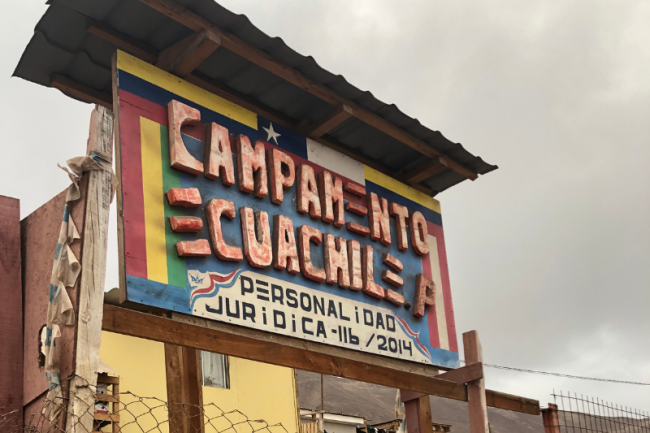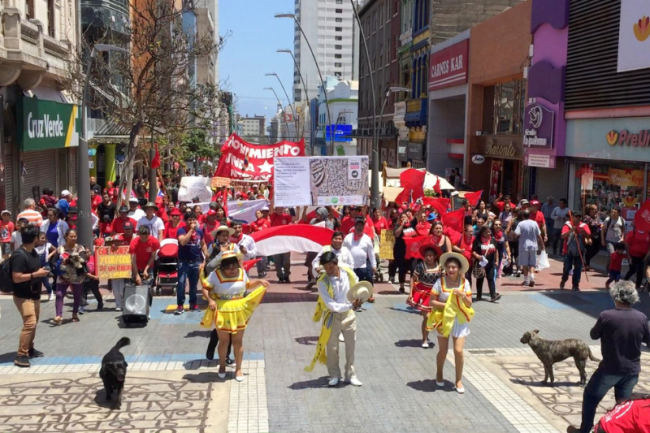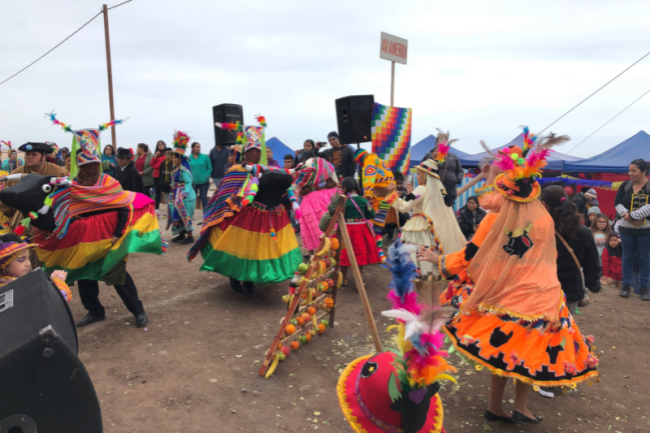
This piece appeared in the Fall 2024 issue of NACLA's quarterly print magazine, the NACLA Report. Subscribe in print today!
Over the past decade, Chile has become one of the main destinations for Latin American migrants in the continent. Many of these newly arrived migrants have settled in the northern city of Antofagasta, near the borders with Bolivia and Peru. Antofagasta gathers the largest proportion of migrants of any Chilean city today.
Almost half of Antofagasta’s migrant population lives in 60 or so informal settlements, or campamentos, that Colombian, Bolivian, Peruvian, and Ecuadorian migrants built on the arid hillsides surrounding the city beginning in 2014. These campamentos are remarkably diverse. According to a 2019 state census, their total population is composed of 28 percent predominantly Black Colombians, 28 percent predominantly Indigenous Bolivians, 14 percent predominantly Indigenous and mestizo Peruvians, and 2.5 percent predominantly Indigenous and Black Ecuadorians, with mainly white and mestizo Chileans comprising the remainder.
From a demographic standpoint, Antofagasta’s predominantly migrant settlements are among the most multinational, multiethnic, and multiracial spaces in Latin America. Despite internal ethnic and racial divisions, migrant leaders, most of them women, have represented them in public as spaces of pan-Latin American unity. Campamentos bear names like “A Roof for a Latin People,” “A New Latin Sunrise,” “United Americas,” “EcuaChilePe,” and “Simón Bolívar.” One campamento has used the motto of being the “first Latin American city in Latin America” as a rallying cry for urbanization. Another one has made demands for environmental protections that the Chilean state typically grants only to Indigenous territories.
Yet spaces such as Antofagasta’s migrant settlements, common in a region experiencing unprecedented levels of internal displacement and migration, are rarely considered in debates about plurinationalism. In Chile, where a constitutional proposal for a plurinational state recently failed, these debates have largely concerned Indigenous people, understood in the essentialist terms of “original peoples” (pueblos originarios) who occupy well-defined territories within the settler colonial nation-state. As sociologist Silvia Rivera Cusicanqui has pointed out in her critique of multicultural reforms in 1990s and early 2000s Bolivia, this essentialist discourse “denies the contemporaneity of [Indigenous] populations.” Rather than recognizing them as the highly mobile urban residents and workers that they are, such discourse largely traps Indigenous people in “indigenist stereotypes of the noble savage and as guardians of nature,” and thus often “excludes them from the struggles of modernity.” This essentialist discourse also disregards Black populations, who, in Chile and elsewhere, are not even afforded the status of ethnic groups.

A groundswell of Indigenous mobilizations led to the downfall of the multiculturalist establishment in Ecuador and Bolivia in the early 2000s. Following constituent processes, the governments of Rafael Correa and Evo Morales passed new plurinational constitutions in 2008 and 2009, respectively. Key to demands for plurinationalism were political and economic sovereignty and autonomy beyond liberal multiculturalism’s largely symbolic institutions of Indigenous protection, representation, and consultation. However, as commentators ranging from Marc Becker, Carmen Martínez Novo, and Thea Riofrancos in Ecuador to Rivera Cusicanqui, Raquel Gutiérrez Aguilar, Penelope Anthias, and Nancy Postero in Bolivia have pointed out, both the Correa and Morales governments continued enforcing structures of domination and extraction that subordinate everyday Indigenous people to white and mestizo majorities.
In this context, what might a plurinationalism from below that recuperates grassroots demands from plurinationalist movements look like? Writing about “the breakdown of the political legitimacy of neoliberalism from above,” feminist theorist and activist Verónica Gago has highlighted a “pluralization of neoliberalism by practices from below.” Gago attends specifically to transnational Indigenous kin networks that articulate a state-imposed “free-market” economic ethos with “communitarian traditions and knowledges” that migrants innovate and experiment with as they move from countryside to city. According to Gago, these hybrid forms lead to a new and potentially radical reorganization of hegemonic notions of freedom, progress, and autonomy.
Taking heed of Gago, can we trace the emergence of a plurinationalism from below in communities like Antofagasta’s migrant campamentos? These migrant struggles highlight the formidable challenges that grassroots plurinationalist movements face, especially after a nationalist and racist backlash from conservative elements in the Chilean state and wider public against the failed plurinationalist project from above.
Chile’s Failed Plurinational Constitution
Chile stands out among its fellow Latin American settler colonial states for having largely rejected the multiculturalist reforms that took hold in other Andean countries beginning in the 1990s. It chose, instead, to meet the Mapuche movement with criminalization and violence.
The constitutional proposal to make Chile a plurinational state that suddenly emerged after the 2019 social uprising, therefore, presented a historic, if arguably premature, political opportunity. On September 4, 2022, two years after an overwhelming majority of Chileans voted to rewrite the Pinochet-era constitution, 62 percent rejected the proposal. Polling data shows that many of those who voted against the constitution did so in part because of their opposition to plurinationalism and Indigenous autonomy. Though surprising from the standpoint of the constitutional reform process, this result was in line with a longer history of genocidal and assimilationist violence against Indigenous and migrant communities in Chile’s southern and northern frontiers.
Important Mapuche political leaders and intellectuals supported the proposal to declare Chile a plurinational state. But, from the start, other Mapuche actors saw the proposal with suspicion. The demand for plurinationalism in Chile was not grounded in Indigenous movements, as it was in Bolivia and Ecuador. Rather, as a collective of Mapuche and other critical scholars argued in an article published in the Winter 2022 NACLA Report, the plurinational constitution sought to institutionally channel and defang more radical demands for the restitution of dispossessed territories in Wallmapu. Instead, they argued, the failed proposal for a plurinational state “laid the foundation for the hegemonic reconstitution of Chile’s political and economic class.”

Right-wing parties have capitalized on widespread feelings of uncertainty and insecurity in the aftermath of the 2019 social uprising, the Covid-19 pandemic, and the failed constitutional reform process. Especially in the country’s northern regions, right-wing forces have efficiently tapped into fears about alleged migrant crime to manufacture a moral panic around immigration. This has led to the resurgence of an organized proto-fascist, anti-migrant movement, with historical roots in early 20th-century paramilitary groups that attacked and deported Bolivians and Peruvians.
As I explored in an article published in the Winter 2022 NACLA Report, under the governments of both Sebastián Piñera (2018-2022) and his progressive successor, current President Gabriel Boric, protesters have burned down migrant encampments and shut down Antofagasta and other northern cities for days at a time. Their pressure has led the state to detain and deport unauthorized migrants, police migrant communities, and militarize the border.
In Chile today, re-envisioning a future for plurinationalist politics urgently requires thinking beyond the failed strategy of plurinationalism from above. A good place to start is Antofagasta. Spontaneous multinational and multiethnic communities in this city and the surrounding northern border region have long offered and continue to offer alternative visions for plurinational politics from below.
Plurinationalism Before the Nation-State
Though the Chilean state conquered the country’s present-day northern regions from Bolivia and Peru in 1883 following the War of the Pacific, it was only able to establish its sovereignty after a violent “Chilenization” campaign ending in the 1920s. Before then, this region was what renowned Chilean historian Sergio González Miranda has described as a “pluriethnic and plurinational” space, with variegated sovereignties and open borders.
The discovery of nitrate in the Atacama Desert in the early 19th century gradually gave rise to dozens of British-, U.S.-, and German-owned mining company towns in the provinces of Antofagasta and Tarapacá, claimed at the time by Bolivia and Peru, respectively. At the highpoint of their growth in 1920, these towns housed around 70,000 Indigenous, mestizo, and white Chilean, Bolivian, and Peruvian workers and their families, according to figures published in Eugenio Garcés Feliú’s 1999 study of the nitrate region. These residents lived in precarious borrowed shacks inside what were known then as campamentos mineros or mining settlements.
A census conducted by the Peruvian state in the province of Tarapacá in 1876 found that close to 44 percent of workers identified as “Indian” (Quechua- and Aymara-speaking people from the Chilean, Bolivian, and Peruvian Andes), 35 percent as “white,” 18 percent as “mestizo,” 2 percent as “Asian,” and 1.5 percent as “Black.” The network of company towns, nitrate extraction and processing sites, and independent pueblos and cities connected by railroads in the desert became known to workers as the pampa salitrera or nitrate pampa, following the Quechua word for a space made habitable.
Read the rest of this article, freely available for a limited time.
Pablo Seward Delaporte is Assistant Professor of Anthropology at Saint Louis University. He studies space, politics, and subjectivity around environmental and social vulnerability in contexts of migration. His first book project examines these questions in Antofagasta’s migrant campamentos.

